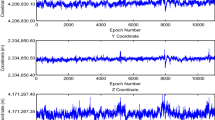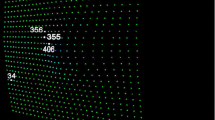Abstract
As a prerequisite of network differential global positioning system applications, the network ambiguity must be determined. Ambiguity resolution and validation are important aspects of this process. However, validation theory is still under investigation. This paper presents an improved network ambiguity validation method that incorporates additional knowledge measured from the network. This process involves the detection of outliers of the baseline measurement errors. By breaking the spatial correlation, incorrectly fixed ambiguities cause the corresponding baseline measurement errors to appear as outliers, which may be discovered and identified with the proposed outlier detection algorithm and outlier identification algorithm, respectively. These detection and identification procedures are iteratively performed until all of the wrong baseline ambiguities are corrected. Because the validation procedure is unconnected to the initial integer ambiguity estimation process, any available ambiguity resolution method may be used to obtain the initial integers, without algorithm correction. When the network ambiguity combinations do not pass the validation algorithm, the method uses a direct estimation algorithm to obtain the correct ambiguity. By using a direct estimation algorithm rather than a search process, this new method consumes less computational time than conventional methods. This study compares the performance of this new method with those of the conventional F-ratio and W-ratio test validation algorithms by using Monte Carlo simulation techniques. Results from a field experiment conducted on data from the United States continuously operating reference stations (US-CORS) reveal that this validation algorithm accelerates the convergence process of ambiguity determination.




Similar content being viewed by others
References
Baarda W (1968) A testing procedure for use in geodetic networks. Publications on geodesy, vol 2, no 5. Rijkscommissie voor Geodesie, Delft, 97 p
Bertiger W, Desai SDD, Haines B, Harvey N, Angelyn WM, Susan O, Jan PW (2010) Single receiver phase ambiguity resolution with GPS data. J Geodesy 84(5):327–337. doi:10.1007/s00190-010-0371-9
Blewitt G (1989) Carrier phase ambiguity resolution for the global positioning system applied to geodetic baselines up to 2000 km. J Geophys Res 94(B8):10187–10203. doi:10.1029/JB094iB08p10187
Blewitt G (2008) Fixed point theorems of GPS carrier phase ambiguity resolution and their application to massive network processing: Ambizap. J Geophys Res 113(B12):B12410. doi:10.1029/2008JB005736
Chen D, Lachapelle G (1995) A comparison of the FASF and least squares search algorithms for on-the-fly ambiguity resolution, Navigation. J Inst Naviga 42(2):371–390
Chen Y, Wang J (1996) Reliability measures for correlated observations. Zeitschrift für Vermessungswesen 121(5):211–219
Counselman CC, Abbot R (1989) Method of resolving radio phase ambiguity in satellite orbit determination. J Geophys Res 94:7058–7064. doi:10.1029/JB094iB06p07058
Cross PA, Hawksbee DJ, Nicolai R (1994) Quality measures for differential GPS positioning. Hydrogr J, Hydrogr Soc 72:17–22
Dong D, Bock Y (1989) Global positioning system network analysis with phase ambiguity resolution applied to crustal deformation studies in California. J Geophys Res 94(B4):3949–3966. doi:10.1029/JB094iB04p03949
Euler HJ, Landau H (1992) Fast GPS ambiguity resolution on-the-fly for the real-time application. In: Proceedings of 6th international geodetic symposium on satellite positioning, Columbus, Ohio, pp 17–20
Fotopoulos G, Cannon ME (2001) An overview of multi-reference station methods for cm-level positioning. GPS Solut 4(3):1–10. doi:10.1007/PL00012849
Gao Y, Li Z (1998) Ionosphere effect and modelling for regional area differential GPS network. In: Proceedings of the 11th international technical meeting of the satellite division of the institute of navigation (ION GPS-98), Nashville, Tennessee, pp 91–97
Gao Y, Li Z, McLellan JF (1997) Carrier phase based regional area differential GPS for decimeter-level positioning and navigation. In: Proceedings of the 10th international technical meeting of the satellite division of the institute of navigation (ION GPS-97), Kansas City, Missouri, pp 1305–1313
Ge M, Gendt G, Dick G, Zhang FP (2005) Improving carrier-phase ambiguity resolution in global GPS network solution. J Geodesy 79:103–110. doi:10.1007/s00190-005-0447-0
Han S, Rizos C (1996a) Integrated methods for instantaneous ambiguity resolution using new-generation GPS receivers. In: Proceedings of IEEE PLANS’96, Atlanta, GA, pp 254–261
Han S, Rizos C (1996b) GPS network design and error mitigation for real-time continuous array monitoring systems. In: Proceedings of the 9th international technical meeting of the satellite division of the institute of navigation (ION GPS-96), Kansas City, Missouri, pp 1827–1836
Hewitson S, Wang J (2006) GNSS receiver autonomous integrity monitoring (RAIM) performance analysis. GPS Solut 10(3):155–170. doi:10.1007/s10291-005-0016-2
Jonge PJ, Tiberius C (1996) The LAMBDA method for integer ambiguity estimation: implementation aspects. LGR-series: Publications of the Delft Geodetic Computing Centre, vol 12. pp 1–49
Kim D, Richard B, Langley (2000) GPS ambiguity resolution and validation: methodologies, trends and issues. In: Proceedings of the 7th GNSS workshop—international symposium on GPS/GNSS, Seoul, Korea, pp 1–9
Leick A (2003) GPS satellite surveying, 3rd edn. Wiley, New York
Li T, Wang J (2012) Some remarks on GNSS integer ambiguity validation methods. Surv Rev 44(326):230–238. doi:10.1179/1752270611Y.0000000027
Mervart L (1995) Ambiguity resolution techniques in geodetic and geodynamic applications of the global positioning system. Geodesy geophysics, Arbeiten in der Schweiz, Schweizerische Geodätische Komnission, Switzerland, pp 1–10
Raquet J, Lachapelle G (1996) Determination and reduction of GPS reference station multipath using multiple receivers. In: Proceedings of the 9th international technical meeting of the satellite division of the institute of navigation (ION GPS-96), Kansas City, Missouri, pp 673–681
Sun H, Cannon ME, Melgard TE (1999) Real-time GPS reference network carrier phase ambiguity resolution. In: Proceedings of institute of navigation technical meeting, Alexandria, VA, pp 133–199
Teunissen PJG (1994) A new method for fast carrier phase ambiguity estimation. In: Proceedings of IEEE PLANS’94, Las Vegas, NV, pp 562–573
Teunissen PJG (1995) The least-squares ambiguity decorrelation adjustment: a method for fast GPS integer ambiguity estimation. J Geodesy 70:65–82
Teunissen PJG (1996) GPS carrier phase ambiguity fixing concepts. In: Kleusberg A, Teunissen PJG (eds) GPS for geodesy. Springer, Berlin, Heidelberg, NY, pp 263–335
Teunissen PJG (2003) An invariant upperbound for the GNSS bootstrapped ambiguity success rate. J Glob Position Syst 2(1):13–17. doi:10.5081/jgps.2.1.13
Teunissen PJG, Verhagen S (2009) GNSS carrier phase ambiguity resolution: challenges and open problems. Observing our changing earth, International Association of Geodesy Symposia 133
Teunissen PJG, Joosten P, Odijk D (1999) The reliability of GPS ambiguity resolution. GPS Solut 2(3):63–69. doi:10.1007/PL00012758
Varner C (2000) DGPS Carrier phase networks and partial derivative algorithms. UCGE reports number 20129, Department of Geomatics Engineering, University of Calgary
Verhagen S (2004) Integer ambiguity validation: an open problem? GPS Solut 8(1):36–43. doi:10.1007/s10291-004-0087-5
Wang J, Chen Y (1994) On the localizability of blunders in correlated coordinates of junction points in densification networks. Aust J Geodesy Photogramm Surv 60:109–119
Wang J, Chen Y (1999) Outlier detection and reliability measures for singular adjustment models. Geomat Res Aust 71:57–72
Wang J, Stewart MP, Tsakiri M (1998) A discrimination test procedure for ambiguity resolution on-the-Fly. J Geodesy 72(11):644–653. doi:10.1007/s001900050204
Wang J, Stewart MP, Tsakiri M (2000) A comparative study of the integer ambiguity validation procedures. Earth Planets Space 52:813–817
Wei M, Schwarz KP (1995) Fast ambiguity resolution using an integer nonlinear programming method. In: Proceedings of the ION GPS-1995, Palm Springs CA, pp 1101–1110
Wübbena G, Bagge A, Seeber G, Volker B, Hankemeier P (1996) Reducing distance dependent errors for real-time precise DGPS applications by establishing reference station networks, In: Proceedings of the ION GPS-96, Kansas City, Missouri, September 1996, pp 1845–1852
Acknowledgments
This work was supported in part by the National Natural Science Foundation of China under grant nos. 61273055 and 61104201. The author would like to thank Prof. Jinling Wang of the University of New South Wales for his valuable discussions on the problem of outlier detection, during the summer program held by the National University of Defense Technology (NUDT) in July, 2011.
Author information
Authors and Affiliations
Corresponding author
Rights and permissions
About this article
Cite this article
Li, X., Wu, M., Zhang, K. et al. An Improved Approach to Network Ambiguity Validation by Applying Outlier Detection to the Baseline Measurement Errors. Surv Geophys 34, 165–180 (2013). https://doi.org/10.1007/s10712-012-9211-1
Received:
Accepted:
Published:
Issue Date:
DOI: https://doi.org/10.1007/s10712-012-9211-1




